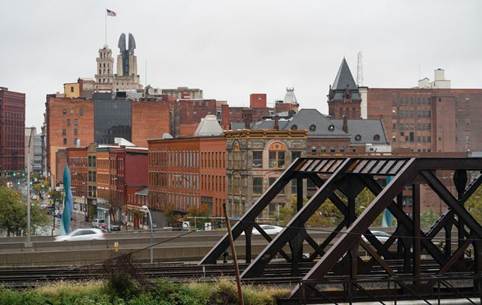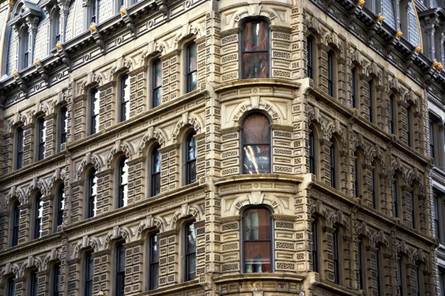
The Evolution of Rochester’s Infrastructure Over the Decades
Rochester has always been a city shaped by what it builds. From the roar of the Genesee River through High Falls to the silent lines of fiber-optic cable beneath city streets, Rochester’s infrastructure reflects its heart and ambition. It’s never just been about roads or buildings.
It’s been about creating systems that support lives: clean water, safe transit, well-lit neighborhoods, vibrant parks, and now, even fast internet. The structures we rely on each day tell a deeper story about where we’ve been and where we’re headed.

Foundations in Water and Industry (Early 1800s–1850s)
The story begins with water. The Genesee River carved Rochester into place, and High Falls powered its growth. By the 1820s, mills crowded the banks, grinding grain, cutting lumber, and churning out the goods of a rising industrial center. The roar of falling water wasn’t just natural beauty, it was economic lifeblood.
Then came the Erie Canal. Completed in 1825, this marvel of engineering passed through the city’s center, connecting Rochester to Albany and Buffalo. It turned local mills into international exporters. Feeder routes and towpaths linked farms to markets. With it came warehouses, loading docks, and the first permanent bridges. The canal became a commercial artery, pulsing with trade and opportunity.
The result? Rochester grew quickly, physically and economically, into one of New York’s first boomtowns. These early investments laid the groundwork for every road and rail line that followed.
Railroads and the Rise of a Regional Hub (1850s–1900s)
As railroads expanded, so did Rochester’s reach. The Erie Canal still played a role, but trains soon dominated long-distance trade. Lines like the New York Central Railroad and the Lehigh Valley Railroad cut east-west across the region, turning Rochester into a true transportation hub.
Freight depots popped up near East Main Street and around Goodman Street Yard. Locomotives rolled through with coal, steel, and grain. Factories in the north and south of the city began syncing their output with schedules from distant cities. The infrastructure shifted, stretching outward along the rails.
This was a time when geography and industry intertwined. Streets followed train lines. Housing developed near depots. Industrial corridors defined the edges of the city. In many ways, the layout still reflects these choices today.
The Streetcar City and Early Urban Planning (1900s–1930s)
By the early 20th century, Rochester looked inward again. Electric streetcars ran through the city’s core and into outlying neighborhoods, eventually giving rise to the Rochester Subway—a rare innovation for a city of its size.
Running in part through the old Erie Canal bed, the subway opened in 1927. It connected downtown to places like Brighton and Charlotte. Though it never fully replaced cars or trolleys, it reflected forward-thinking transit design.
This era also brought better planning. Frederick Law Olmsted, Jr., the son of Central Park’s famed designer, helped design Rochester’s park system. Seneca, Highland, and Genesee Valley Parks weren’t just green spaces—they were connected by parkways, creating a flow between nature and city.
At the same time, utilities modernized. Water filtration, gas lighting, electricity, and sanitation turned Rochester into a cleaner, healthier place. Residents could count on basic services in ways that earlier generations couldn’t.
Postwar Expansion and the Automobile Era (1940s–1960s)
After World War II, Rochester boomed again, but this time outward. With the rise of the automobile, investment poured into highways and suburban housing. People left the city center for newer homes in Irondequoit, Brighton, and Greece.
Major projects included:
- Interstate 490, cutting across the city
- The Inner Loop, circling downtown
- Route 104 and 590, forming a loose beltway
These projects made commuting easier but came at a cost. Neighborhoods were split by concrete walls and cloverleaf ramps. In places like the Third Ward and parts of Marketview Heights, homes were demolished and communities displaced. The city lost density, and with it, some of its soul.
The postwar era favored speed and scale over connection. Rochester’s infrastructure grew, but not always wisely.
Urban Renewal and Downtown Transformation (1960s–1980s)
Faced with downtown decline, Rochester doubled down on renewal. Glass towers replaced brick rowhouses. Midtown Plaza opened in 1962 as the nation’s first urban indoor shopping mall. Chase Tower, Xerox Square, and other modern buildings rose into the skyline.
But the shine had shadows. These projects often erased what was already there. African-American communities bore the brunt of displacements. Broad Street widened, and in doing so, quiet blocks disappeared. Public spaces felt less public.
This era aimed to modernize. But in doing so, it sometimes overlooked the human scale. Green space was paved over. Community ties weakened. The infrastructure dazzled, but not always for everyone.
Deindustrialization and Infrastructure Aging (1980s–1990s)
The 1980s brought hard truths. Kodak, Xerox, and Bausch & Lomb all downsized. Manufacturing jobs dried up. With fewer tax dollars and lower demand, infrastructure began to strain.
Cracked bridges. Failing water mains. Delayed transit repairs. The signs were everywhere.
Residents stepped up. Community groups fought to preserve historic bridges over the Genesee. Neighborhood associations advocated for sidewalk repairs and better lighting. There was growing recognition that infrastructure wasn’t just physical—it was social. And it needed care.
Reinvestment and Smart Growth (2000s–2010s)
Hope returned in new forms. Instead of tearing down, Rochester started to reuse. Old buildings were rehabbed. Public spaces got facelifts. Walkability and access became goals again.
Key projects stood out:
- High Falls revitalization, turning industrial ruins into gathering spots
- Rochester Public Market’s expansion, keeping local commerce thriving
- Erie Harbor development, mixing green space with new housing
Bike lanes appeared along East Avenue and South Clinton. Pocket parks filled gaps left by demolition. New zoning encouraged apartments over shops, bringing life back to long-quiet blocks.
Smart growth wasn’t about getting bigger. It was about getting better.

The Inner Loop Transformation: Reconnecting the City
Nowhere is Rochester’s shift clearer than the Inner Loop East project. Once a barrier slicing through neighborhoods, the sunken expressway was filled in and replaced with a street-level boulevard.
This wasn’t just construction. It was healing. The project reconnected Grove Place, East End, and the Neighborhood of the Arts. It created space for housing, bike lanes, and sidewalks. It slowed traffic and welcomed people back.
Future phases like Inner Loop North are in motion, shaped by community voices. Public meetings, online forums, and design charrettes have all played a role. This time, the city is listening.
Digital Infrastructure and the Modern Era (2010s–Present)
Today, infrastructure includes more than concrete. Broadband is as vital as a bridge. And Rochester has stepped up.
With help from local tech firms and partnerships with RIT and the University of Rochester, the city has expanded fiber access and installed smart traffic sensors. These upgrades power education, small businesses, and public safety.
Meanwhile, ROC the Riverway reimagines the riverfront. It blends flood control with parks, trails, and performance spaces. Green infrastructure—like permeable pavement and bioswales—helps manage stormwater naturally.
Modern infrastructure, here, blends digital speed with natural balance. Downtown Rochester has become home of numerous local Rochester-based personal injury firms.
Challenges and Lessons for the Future
Despite progress, Rochester still faces tough questions. Much of its infrastructure remains old. Water systems need upgrades. Some roads and bridges weren’t built for today’s climate realities.
Equity matters, too. Some neighborhoods still wait longer for repairs. Others lack safe sidewalks or fresh investment. Public engagement is better, but not perfect.
Current debates include:
- Balancing historic preservation with needed change
- Funding new transit while maintaining old systems
- Building flood resilience as weather grows more extreme
There’s no one answer. But there is a growing recognition that people should shape infrastructure—not the other way around.
Building the Next Rochester
Every era of Rochester’s infrastructure has reflected its values. We’ve built for industry, for cars, for renewal, and now, for people. As we look ahead, we have the chance to build a city that’s more connected, more sustainable, and more inclusive than ever before.

What Sets Us Apart From The Rest?
Horn Wright, LLP is here to help you get the results you need with a team you can trust.
-
Client-Focused ApproachWe’re a client-centered, results-oriented firm. When you work with us, you can have confidence we’ll put your best interests at the forefront of your case – it’s that simple.
-
Creative & Innovative Solutions
No two cases are the same, and neither are their solutions. Our attorneys provide creative points of view to yield exemplary results.
-
Experienced Attorneys
We have a team of trusted and respected attorneys to ensure your case is matched with the best attorney possible.
-
Driven By Justice
The core of our legal practice is our commitment to obtaining justice for those who have been wronged and need a powerful voice.

